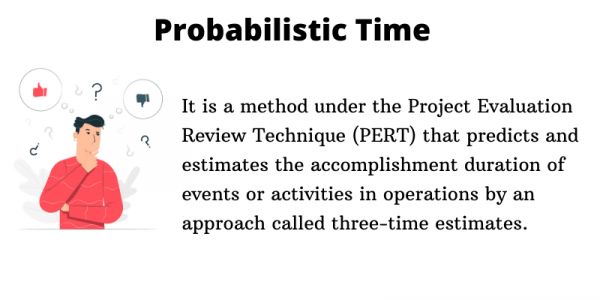In project management, one of the most difficult tasks is estimating the time required to complete a task or project. The probabilistic time estimation technique is a statistical method that can be used to create more accurate estimates. One of the things that PMPs must know is how to create a probabilistic schedule. In short, a probabilistic schedule is a schedule that takes into account the uncertainty of the future.
This type of schedule is beneficial because it can help project managers understand the risks of a project and plan for them accordingly. It is a recommended practice for all project managers, and it is a required skill for the Project Management Professional (PMP) certification.
- When to use the probabilistic time technique
- Calculating Probabilistic Time
- Understanding the differences between Probabilistic Vs Deterministic Schedule
- Examples
- Main Benefits when doing Probabilistic Scheduling
- What is Probabilistic Time in Project Management?
- What are the differences between Probabilistic Time Technique and Deterministic Technique?
- What are the main benefits of Probabilistic Time of tasks?
When to use the probabilistic time technique
This technique is used when there is uncertainty about the project’s duration.
This is based on the beta distribution, which is a probability distribution that is used to model the variability of a project’s duration. Also, this technique is used to generate a range of possible durations for a project, based on its past performance.
As well, this technique is often used in project management to generate a range of possible project durations and to help identify risks and opportunities as it is a valuable tool for making decisions about how to allocate resources and manage a project.

Calculating Probabilistic Time
Any project manager worth their salt knows that one of the most important aspects of their job is creating a schedule. And not just any schedule – a schedule that is realistic and achievable. This can be a difficult task, as there are so many variables to consider.
One way to create a schedule that takes into account all of the necessary variables is to use a technique called a probabilistic time schedule.
This type of scheduling takes into account the inherent uncertainty in any project and uses methods such as Monte Carlo simulations to create a schedule that is as accurate as possible.
- A probabilistic schedule is a time-phased schedule that shows the probability of completion for each activity. The schedule is based on the estimated duration of each activity and the probability that the activity will be completed on time.
- The estimated duration of each activity is calculated using the three-point estimate technique. This technique uses the most likely time, the optimistic time, and the pessimistic time to calculate the estimated duration.
- The probability of completion for each activity is calculated using the beta probability distribution. This distribution is used to calculate the probability that an activity will be completed within a certain time period.
Understanding the differences between Probabilistic Vs Deterministic Schedule
In Project scheduling, you can use two main types: probabilistic and deterministic.
Probabilistic project management is an approach that uses statistical models to predict the outcome of a project.
Deterministic project management is an approach that uses a single sequence of events to determine the outcome of a project.
So, which type of schedule is right for your project? It depends on a number of factors, including the nature of the project, the team’s experience, and the level of uncertainty.
In general, deterministic scheduling is used for smaller projects with less uncertainty, while probabilistic scheduling is used for larger projects with more uncertainty.
Examples
Probabilistic time for completion is commonly used in conjunction with the Critical Path Method (CPM) to create a more accurate estimate of the project’s completion date.
There are several different methods that can be used to calculate probabilistic time for completion. The most common method is the Monte Carlo simulation.
In this method, a computer is used to generate a large number of possible project scenarios.
Each scenario is based on the chance of occurrence of different events.
The results of the simulations are then used to create a probability distribution for the project’s completion date. Other methods for calculating the probabilistic time for completion include the use of expert judgment, historical data, and statistical models. No matter which method is used, the goal is to create a more accurate estimate of the project’s completion date.
Main Benefits when doing Probabilistic Scheduling
Considering that a probabilistic schedule is a type of schedule that uses probability to account for uncertainty in the project. It means that instead of using a single estimate for each task, you use a range of estimates.
This range is based on the degree of uncertainty for each task.
The benefits of using a probabilistic schedule are that it can help you:
- Anticipate problems early
- Make more realistic plans
- Reduce the impact of problems when they do occur
- Improve communication with stakeholders by giving clear and key schedule documentation
If you are looking for a way to improve your project management, then a probabilistic schedule may be the answer
What is Probabilistic Time in Project Management?
The probabilistic time estimation technique is a statistical approach to estimating the time required to complete a project.
What are the differences between Probabilistic Time Technique and Deterministic Technique?
The main difference between the two is that deterministic scheduling uses a single set of fixed values for each activity, while probabilistic scheduling uses a range of values for each activity.
What are the main benefits of Probabilistic Time of tasks?
There are a number of benefits to calculating probabilistic times in project management. Probabilistic times can help identify risks early on in the project, they can provide a more accurate estimate of the project duration, and can help project managers better understand the risks involved in a project.
